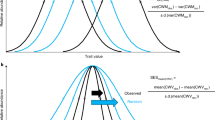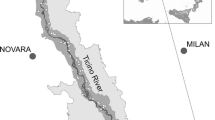Abstract
In ecosystems where large-scale disturbances are infrequent, the mode of succession may be difficult to discern and floristic surveys alone cannot be used determine the underlying processes causing vegetation change. To determine the causes of vegetation change in response to a large-scale fire event, we combined traditional floristic survey data, plant functional traits and environmental variables in a model-based solution to the fourth-corner problem. This approach allowed us to describe the trait-environment relationship and provides an intuitive matrix of environment by trait interaction coefficients. We could then quantify the strength and direction of associations between plant traits, species life-forms and environmental factors in two alpine plant communities over nine years post-fire. Initially, the fire drastically reduced vegetation cover and species density to very low levels. The fourth-corner analysis interaction coefficients indicated that over the course of the nine-year study a high abundance of graminoids, a low abundance of shrubs, tall species and those with high leaf dry matter content had the strongest associations with the two plant communities. We also found evidence for functional homogenisation between these two communities using this novel technique. Analysing plant traits and species responses post-fire in this manner can be used to infer the ecological processes driving shifts in vegetation.


Similar content being viewed by others
References
Attiwill PM (1994) Ecological disturbance and the conservative management of eucalypt forests in Australia. For Ecol Manage 63:301–346. doi:10.1016/0378-1127(94)90115-5
Ballantyne M, Pickering CM (2015) Shrub facilitation is an important driver of alpine plant community diversity and functional composition. Biodivers Conserv 24(8):1859–1875. doi:10.1007/s10531-015-0910-z
Beckage B, Platt WJ, Gross LJ (2009) Vegetation, fire, and feedbacks: a disturbance-mediated model of savannas. Am Nat 174:805–818. doi:10.1086/648458
Brown AM, Warton DI, Andrew NR, Binns M, Cassis G, Gibb H (2014) The fourth-corner solution–using predictive models to understand how species traits interact with the environment. Methods Ecol Evol 5:344–352. doi:10.1111/2041-210X.12163
Callaway RM et al (2002) Positive interactions among alpine plants increase with stress. Nature 417:844–848. doi:10.1038/nature00812
Camac JS, Williams RJ, Wahren CH, Morris WK, Morgan JW (2013) Post-fire regeneration in alpine heathland: does fire severity matter? Austral Ecol 38:199–207. doi:10.1111/j.1442-9993.2012.02392.x
Cornelissen JHC et al (2003) A handbook of protocols for standardised and easy measurement of plant functional traits worldwide. Aust J Bot 51:335–380. doi:10.1071/BT02124
Cornwell WK, Ackerly DD (2009) Community assembly and shifts in plant trait distributions across an environmental gradient in coastal California. Ecol Monogr 79:109–126. doi:10.1890/07-1134.1
Costin AB, Gray M, Totterdell CJ, Wimbush DJ (2000) Kosciuszko alpine flora. CSIRO, Melbourne
Dale VH et al (2001) Climate change and forest disturbances: climate change can affect forests by altering the frequency, intensity, duration, and timing of fire, drought, introduced species, insect and pathogen outbreaks, hurricanes, windstorms, ice storms, or landslides. Bioscience 51:723–734. doi:10.1641/0006-568(2001)051[0723:CCAFD]2.0.CO
Diaz S, Cabido M (1997) Plant functional types and ecosystem function in relation to global change. J Veg Sci 8:463–474. http://www.jstor.org/stable/3237198
Dolédec S, Chessel D, Ter Braak C, Champely S (1996) Matching species traits to environmental variables: a new three-table ordination method. Environ Ecol Stat 3:143–166. doi:10.1007/BF02427859
Dray S, Legendre P (2008) Testing the species traits-environment relationships: the fourth-corner problem revisited. Ecology 89:3400–3412. doi:10.1890/08-0349.1
Easterling DR, Evans J, Groisman PY, Karl T, Kunkel KE, Ambenje P (2000) Observed variability and trends in extreme climate events: a brief review. Bull Am Meteorol Soc 81:417–425
Fraterrigo JM, Rusak JA (2008) Disturbance-driven changes in the variability of ecological patterns and processes. Ecol Lett 11:756–770. doi:10.1111/j.1461-0248.2008.01191.x
Ghermandi L, Guthmann N, Bran D (2004) Early post-fire succession in northwestern Patagonia grasslands. J Veg Sci 15:67–76. doi:10.1111/j.1654-1103.2004.tb02238.x
Gibb H et al (2015a) Responses of foliage-living spider assemblage composition and traits to a climatic gradient in Themeda grasslands. Austral Ecol 40:225–237. doi:10.1111/aec.12195
Gibb H, Stoklosa J, Warton D, Brown A, Andrew N, Cunningham S (2015b) Does morphology predict trophic position and habitat use of ant species and assemblages? Oecologia 177:519–531. doi:10.1007/s00442-014-3101-9
Good RB (1992) Kosciusko heritage. The National Parks and Wildlife Service of New South Wales, Sydney
Hastie T, Tibshirani R, Friedman J (2009) The elements of statistical learning: data mining, inference and prediction, 2nd edn. Springer, New York
Hennessy K, et al (2005) Climate change impacts on fire-weather in south-east Australia. Climate impacts group, CSIRO atmospheric research and the australian government bureau of meteorology, Aspendale
Hennessy K et al (2007) Climate change effects on snow conditions in mainland Australia and adaptation at ski resorts through snowmaking. Clim Res 35:255. doi:10.3354/cr00706
Hooper DM, Vitousek PM (1997) The effects of plant composition and diversity on ecosystem processes. Science 277:1302–1305. doi:10.1126/science.277.5330.1302
Hui FK (2016) Boral–Bayesian ordination and regression analysis of multivariate abundance data in R. Methods Ecol Evol. doi:10.1111/2041-210X.12514
Kahmen S, Poschlod P (2004) Plant functional trait responses to grassland succession over 25 years. J Veg Sci 15:21–32. doi:10.1111/j.1654-1103.2004.tb02233.x
Keith DA, Holman L, Rodoreda S, Lemmon J, Bedward M (2007) Plant functional types can predict decade scale changes in fire-prone vegetation. J Ecol 95:1324–1337. doi:10.1111/j.1365-2745.2007.01302.x
Kirkpatrick J, Bridle K, Wild A (2002) Succession after fire in alpine vegetation on Mount Wellington, Tasmania. Aust J Bot 50:145–154. doi:10.1071/BT00081
Kruger FJ, Bigalke RC (1984) Fire in fynbos. In: de Booysen PV, Tainton NM (eds) Ecological effects of fire in South African ecosystems. vol 48. Springer, pp 67–114
Lavorel S, Garnier E (2002) Predicting changes in community composition and ecosystem functioning from plant traits. Funct Ecol 16:545–546. doi:10.1046/j.1365-2435.2002.00664.x
Lavorel S et al (2008) Assessing functional diversity in the field–methodology matters! Funct Ecol 22:134–147. doi:10.1111/j.1365-2435.2007.01339.x
Legendre P, Galzin R, Harmelin-Vivien ML (1997) Relating behavior to habitat: solutions to the fourth-corner problem. Ecology 78:547–562. doi:10.1890/0012-9658(1997)078[0547:RBTHST]2.0.CO;2
McDougall K, Walsh N, Wright G (2015) Recovery of treeless subalpine vegetation in Kosciuszko National Park after the landscape-scale fire of 2003. Aust J Bot 63:597–607. doi:10.1071/BT14319
McGill BJ, Enquist BJ, Weiher E, Westoby M (2006) Rebuilding community ecology from functional traits. Trends Ecol Evol 21:178–185
McLuckie J, Petrie AH (1927) The vegetation of the Kosciusko Plateau I. The plant communities. In: Proc. Linn. Soc. NSW, vol. 52, pp 187–221
Michalet R, Schöb C, Lortie CJ, Brooker RW, Callaway RM (2014) Partitioning net interactions among plants along altitudinal gradients to study community responses to climate change. Funct Ecol 28:75–86. doi:10.1111/1365-2435.12136
Morgan JW (1999) Defining grassland fire events and the response of perennial plants to annual fire in temperate grasslands of south-eastern Australia. Plant Ecol 144:127–144. doi:10.1023/A:1009731815511
Pausas JG, Bradstock RA, Keith DA, Keeley JE (2004) Plant functional traits in relation to fire in crown-fire ecosystems. Ecology 85:1085–1100. doi:10.1890/02-4094
Pickering CM, Butler S (2009) Patterns in vascular plant species density in tall alpine herbfield along an increasing altitudinal gradient in an Australian alpine region. Aust J Bot 57:210–220. doi:10.1071/BT08202
Pitman A, Narisma G, McAneney J (2007) The impact of climate change on the risk of forest and grassland fires in Australia. Clim Change 84:383–401. doi:10.1007/s10584-007-9243-6
Purdie RW, Slatyer R (1976) Vegetation succession after fire in sclerophyll woodland communities in south-eastern Australia. Aust J Ecol 1:223–236. doi:10.1111/j.1442-9993.1976.tb01111.x
Smith MD, Knapp AK (1999) Exotic plant species in a C4-dominated grassland: invasibility, disturbance, and community structure. Oecologia 120:605–612. doi:10.1007/s004420050896
Spasojevic MJ, Suding KN (2012) Inferring community assembly mechanisms from functional diversity patterns: the importance of multiple assembly processes. J Ecol 100:652–661. doi:10.1111/j.1365-2745.2011.01945.x
Ter Braak CJ, Cormont A, Dray S (2012) Improved testing of species traits-environment relationships in the fourth-corner problem. Ecology 93:1525–1526. doi:10.1890/12-0126.1
Thonicke K, Venevsky S, Sitch S, Cramer W (2001) The role of fire disturbance for global vegetation dynamics: coupling fire into a dynamic global vegetation model. Glob Ecol Biogeogr 10:661–677. doi:10.1046/j.1466-822X.2001.00175.x
Turner MG, Baker WL, Peterson CJ, Peet RK (1998) Factors influencing succession: lessons from large, infrequent natural disturbances. Ecosystems 1:511–523. doi:10.1007/s100219900047
Van Langevelde F et al (2003) Effects of fire and herbivory on the stability of savanna ecosystems. Ecology 84:337–350. doi:10.1890/0012-9658(2003)084[0337:EOFAHO]2.0.CO;2
Van Wilgen B, Forsyth G (1992) Regeneration strategies in fynbos plants and their influence on the stability of community boundaries after fire. In: Fire in South African mountain fynbos. Springer, pp 54–80
Venn SE, Morgan JW, Green PT (2009) Do facilitative interactions with neighboring plants assist the growth of seedlings at high altitudes in alpine Australia? Arct Antarct Alp Res 41:381–387. doi:10.1657/1938-4246-41.3.381
Venn SE, Green K, Pickering CM, Morgan JW (2011) Using plant functional traits to explain community composition across a strong environmental filter in Australian alpine snowpatches. Plant Ecol 212:1491–1499. doi:10.1007/s11258-011-9923-1
Villeger S, Mason NWH, Mouillot D (2008) New multidimensional functional diversity indices for a multifaceted framework in functional ecology. Ecology 89:2290–2301. doi:10.1890/07-1206.1
Wahren C, Walsh N (2000) Impact of fire in treeless subalpine vegetation at Mt Buffalo National Park, 1982–1999. Unpublished report to the Australian Alps Liaison Committee by La Trobe University, Melbourne
Wahren CH, Papst WA, Williams RJ (2001) Early post-fire regeneration in subalpine heathland and grassland in the Victorian Alpine National Park, south-eastern Australia. Austral Ecol 26:670–679. doi:10.1046/j.1442-9993.2001.01151.x
Warton DI et al (2015a) So many variables: joint modeling in community ecology. Trends Ecol Evol 30:766–779
Warton DI, Foster SD, De’ath G, Stoklosa J, Dunstan PK (2015b) Model-based thinking for community ecology. Plant Ecol 216:669–682. doi:10.1007/s11258-014-0366-3
Weiher E, Keddy PA (1995) Assembly rules, null models, and trait dispersion: new questions from old patterns. Oikos. doi:10.2307/3545686
Weiher E, Werf A, Thompson K, Roderick M, Garnier E, Eriksson O (1999) Challenging Theophrastus: a common core list of plant traits for functional ecology. J Veg Sci 10:609–620. doi:10.2307/3237076
Westoby M (1998) A leaf-height-seed (LHS) plant ecology strategy scheme. Plant Soil 199:213–227. doi:10.1023/A:1004327224729
Westoby M, Wright IJ (2006) Land-plant ecology on the basis of functional traits. Trends Ecol Evol 21:261–268
Westoby M, Falster DS, Moles AT, Vesk PA, Wright IJ (2002) Plant ecological strategies: some leading dimensions of variation between species. Annu Rev Ecol Syst 33:125–159. doi:10.1146/annurev.ecolsys.33.010802.150452
Williams RJ et al (2008) Large fires in Australian alpine landscapes: their part in the historical fire regime and their impacts on alpine biodiversity. Int J Wildland Fire 17:793–808. doi:10.1071/WF07154
Wimbush D, Forrester R (1988) Effects of rabbit grazing and fire on a subalpine environment II. Tree vegetation. Aust J Bot 36:287–298. doi:10.1071/BT9880287
Yates ML, Andrew NR, Binns M, Gibb H (2014) Morphological traits: predictable responses to macrohabitats across a 300 km scale. Peer J 2:e271. https://doi.org/10.7717/peerj.271
Zedler PH, Gautier CR, McMaster GS (1983) Vegetation change in response to extreme events: the effect of a short interval between fires in California chaparral and coastal scrub. Ecology 64:809–818. doi:10.2307/1937204
Acknowledgments
We thank the Cooperative Research Centre for Sustainable Tourism, the National Climate Change Adaptation Research Facility and New South Wales National Parks and Wildlife Service for funding and logistical support. We thank Wendy Hill, Andrew Bryant, Andrew Growcock, Daniel Guitart, Daryl Robinson, Jeremy Carrington, Rachel Hill, Sebastian Rossi, Tanya Fountain and Zarni Bear for assistance with the fieldwork. We thank John Morgan for useful comments on an early draft of the manuscript and David Warton for guidance in fitting the fourth-corner models.
Author contribution statement
CMP conceived and designed the study and conducted a large proportion of the fieldwork, SAB conducted fieldwork and did the initial analyses, SEV wrote the manuscript and developed the analytical ideas in conjunction with ADL, who also conducted and generated the final analyses. SEV, CMP and ADL edited the manuscript.
Author information
Authors and Affiliations
Corresponding author
Additional information
Communicated by Katherine L Gross.
Electronic supplementary material
Below is the link to the electronic supplementary material.
Rights and permissions
About this article
Cite this article
Venn, S.E., Pickering, C.M., Butler, S.A. et al. Using a model based fourth-corner analysis to explain vegetation change following an extraordinary fire disturbance. Oecologia 182, 855–863 (2016). https://doi.org/10.1007/s00442-016-3700-8
Received:
Accepted:
Published:
Issue Date:
DOI: https://doi.org/10.1007/s00442-016-3700-8




